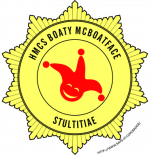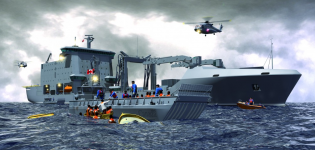April 1, 2016 | Vol 72, No 04
Starbound dockside at Dakota Creek Industries after completion of the lengthening project. Photo courtesy of Dakota Creek Industries, Inc.
In the past two decades, there has been a paradigm shift in global fishing regulations that has incentivized the construction of large fishing vessels capable of bringing ship owners higher profits through economies of scale. Following the moratorium on all large pelagic driftnet fishing vessels ratified internationally in 1991, new fishing regulations focus on catch quotas rather than fishing vessel size restrictions to ensure sustainable fisheries.
With vessel size restrictions lifted, owners can now opt to build large vessels incorporating machinery that extends their processing capability. Among the most common technologies driving interest in large vessels are fish meal plants that process fish scraps – typically thrown overboard in decades past – into fish oil and fish meal.
Fish oil can be used for auxiliary power and steam generation aboard fishing vessels and in a wide range of consumer products shore-side. Fish meal is used regularly as a fertilizer in agriculture, and its sale can increase the profitability of some vessels by almost 30 percent.
At the same time, the Pacific Northwest fishing fleet is aging, and many owners are faced with the fiscal realities of replacement in the upcoming decade. As a result of the 1991 construction moratorium that nearly halted new building in the 1990s, at the time of writing the average catcher is approaching nearly 40 years of age. If the size of the present fleet is to be maintained into the future, ship owners could find themselves playing catch-up and spending cumulatively on the order of $16 billion in upcoming years on new vessels. For owners of the largest ships, the cost of a new build is significant, with some estimates at upwards of $150 million for a new catcher-processor. As a result, owners are seeking alternatives to new building that extend the life and capacity of their vessels, meanwhile hedging the risks inherent to a $100 million or more investment in an industry with an erratic regulatory past, volatile product markets, and an uncertain future.
Aleutian Spray Fisheries' catcher-processor C/P Starbound, a formerly 240-foot catcher-processor, has been operating faithfully between Seattle, Dutch Harbor, and the Alaska Pollock Fishery since her launch in 1989. She was originally constructed at Dakota Creek Industries (DCI) of Anacortes, Washington and designed by Guido Perla & Associates (GPA) of Seattle. Starbound was built through the collaborative efforts of Aleutian Spray Fisheries (ASF) owner Henry Swasand, a Norwegian immigrant naval architect and unmistakably American fisherman, Guido F. Perla, a naval architect based out of the Ballard Fishermen's Terminal at the time, and Dick Nelson, an esteemed shipbuilder at DCI. Swasand had acquired a Bergen diesel engine in the late 80s and wanted a catcher-processor in his fleet capable of replacing the predominantly foreign-owned processors that dominated the Alaska Pollock Fishery at the time. Perla and Nelson were happy to oblige.
At the time of her construction, the original Starbound design was shortened by the removal of parallel midbody due to budgetary constraints on the project. The fish processing deck was scaled down accordingly. The reduction in length over Perla's original design meant that there was no room at the time for a fish meal plant that would later become the state-of-the-art for catcher-processors.
After regulatory shifts toward catch quotas that necessitated increased processing efficiency, the need for a fish meal plant became apparent to Starbound's owners, which still includes the Swasand family.
In 2015, GPA was contracted to begin design on a new 60-foot midbody section to extend Starbound to 300 feet overall. ASF's team of Cary Swasand and Starbound Captain Karl Bratvold, with Cory Kaldestad and Chief Engineer Henry Vanderbeek, approached GPA and DCI to perform the feasibility study and ultimately the conversion.
ASF deemed conversion preferable to new construction for several reasons. For one, Starbound had been impeccably maintained by ASF over her 25 years at sea, and where conversion may not have made sense for many older vessels because of corrosion and other wear-and-tear, Starbound's framing and shell plating was wonderfully preserved in spite of her age. In addition, the fact that Starbound's scantlings had originally been designed to suit a longer vessel made the lengthening even more feasible. Finally, conversion made great fiscal sense. ASF did not need additional capacity on Starbound for finished fillets and surimi – no provision was made during the lengthening to increase cargo space for this purpose. Rather, because the catch is limited by quotas both owned and leased, ASF merely needed to increase the capacity of Starbound for downstream products: fish meal and fish oil. A 60-foot midbody addition would give ASF a means of maximizing their profits for each catch quota at less than half the cost of a new vessel offering the same capability.
Prior to conversion, Starbound measured 240 feet overall with a beam of 48 feet and a load line displacement of 3,802 LT. After conversion, her overall length measured 300 feet and her displacement increased to 4,571 LT. The boat was cut at frame 64-1/2, deemed the best location for the cut because a cut there preserved an unloading elevator trunk serving the forward fish cargo hold and was located at the location of the side tangents where the parallel midbody could be integrated with the least impact.
Hull scans were taken at the location of the incision to establish the shell plating seam locations and the heights of the decks. Scantling design for the new midbody was carried out according to Det Norske Veritas' steel vessel rules.
A new Haarslev-designed fish meal plant, replete with two fish meal storage holds offering a combined capacity of 21,800 ft3, a structurally integrated raw material hopper, and a structurally integrated control room, were added to the new midbody below the main deck. A new Marel processing plant, with updated surimi processing capability provided by the addition of a new bank of plate freezers, was added to the fish processing plant on the main deck. On the upper deck, deckhouses were expanded to make room for a fire suppression room, a reverse osmosis fresh water plant room, two hydraulic machinery rooms, and two sugar storage rooms holding 40 metric tons of sugar. A break room was also expanded.
Elsewhere on Starbound, new rooms were added aft of the existing superstructure at the cabin deck to accommodate a stateroom with four more berths and a ship's office. An office was relocated from the upper deck to the cabin deck to make room for yet another new stateroom accommodating two more berths on the upper deck. Also on the cabin deck, in anticipation of the lengthening, ASF installed two new Rapp GSW10000 Gilson winches offering up to 50 tons of pull – an increase of 20 tons over the previously installed winches. The Gilson blocks were redesigned as sheaves hard mounted to the Gilson gantry at the urging of Bratvold and Vanderbeek, who realized the advantages in swing and noise reduction over their original pad eye and shackle-supported blocks.
A new hydraulic crane replaced the original deck crane on the starboard side of the vessel at the foc'sle deck and will serve as an unloading crane for fish meal stored in the fish meal holds below the main deck. By design, fish meal coming off the bagging line will be bagged and packed into 1.4 ton supersacks and then moved via conveyor to one of the fish meal holds (port or starboard, outboard of the plant). From the conveyor's terminus at the aft position in the holds, one of the 2-ton American Crane Co. bridge cranes will move the supersacks forward and aft and facilitate stacking within each hold. During unloading, supersacks can be moved fore, aft, and athwartships to the starboard unloading trunk, where the new Rapp crane will pick the bag and place it shoreside.
(
LEFT ABOVE) Starbound under construction at Dakota Creek Industries of Anacortes, Washington in 1989.
A final component of the Starbound lengthening was an extensive repower and total drive train replacement. Soon after Starbound began operating, the power required for towing her net so taxed the original 2,550 kW Bergen BRM-6 engine that the shaft-driven generator was effectively decommissioned in place. To accommodate increased power demand and reinstate the use of the shaft generator, ASF selected an MaK 9M32E delivering 4,650 kW of power. With the original Baylor M446LTT-324 shaft-driven generator overhauled and re-installed, up to 1,800 kW of power can be diverted to power Starbound's electrical equipment. 2,550 kW reserved for propulsion and delivered via a new Reintjes reduction gear with a new shaft and a new controllable pitch propeller. Pursuant to the repower, the exhaust system was also completely overhauled. A new boiler was installed.
With Starbound's conversion complete, she will no doubt provide years of faithful service to ASF and her crew. When she was first constructed, Starbound's legacy as an American designed, built, and owned vessel was foremost in the minds of Swasand, Perla, and Nelson. As Perla puts it: "American history is based on smart people getting together to achieve a goal and [the Starbound lengthening project has] honored that history of American ingenuity."
Matthew Groff is a graduate of Webb Institute and naval architect at Guido Perla & Associates (GPA) in Seattle, WA where he assumed the role of project manager for the Starbound project in October 2015.










